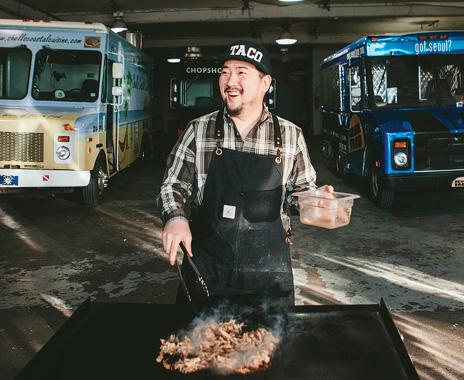The food-truck boom five years ago ushered in a new age for street foods, with obscure international dishes suddenly becoming smash hits in the U.S. That same food-truck movement also made popular new fusion items, with operators mixing and matching global street flavors to create wildly inventive new options.
Such was the case for David Choi, who hit the streets of St. Louis with his food truck Seoul Taco in 2011. The concept, which paired Korean barbecue with popular Mexican flavors, quickly became a hit with its build-your-own, Korean-inspired tacos, quesadillas, burritos, bowls, and nachos. The fast-casual concept has since grown to four brick-and-mortar locations in St. Louis; Columbia, Missouri; Champaign, Illinois; and, most recently, Chicago.
Choi explains how his Korean-American heritage inspired his creative street-food concept.
Why did you start Seoul Taco?
It came from my passion for Korean cuisine. At the time, I had just gotten out of college and was still living with my parents in the basement. Out of boredom, I just started learning more about how to prepare the food—really learning the process of it. That’s how I got the passion for it.
What inspired the Mexican-Korean fusion menu?
I had lived in Chicago, and Chicago has some great Mexican influence. I lived out there for a few years before I moved back in with my parents. I fell in love with the Mexican street food in Chicago. At that time, Roy Choi (no relation) in L.A. started the Kogi truck, and I love traveling and trying out different cuisines. Every city I went to, people were like, “You should try this Korean taco.” And that just blew my mind. I started creating Korean tacos and replicating that for my friends and family, and everyone loved it.
What are some of Seoul Taco’s signature flavors?
My marinade that we use at Seoul Taco is sort of a hybrid between my grandma’s and mom’s. Being born and raised in America, I have a different type of palate, so I know the more general tastes that people like here as well. So I tweaked both recipes and made some of my own. It ended up working well. It has sweet notes of Korean barbecue, but I also really studied the tenderizing procedures. It’s really all in the marination.
How do you maintain a street-food mentality in a brick-and-mortar environment?
First, I think with street food, it starts with the food; it’s having a product that people love. Also, you have to make it accessible, so when people are on the go, they can have any of our dishes. Then it’s keeping it affordable. Street food isn’t something that will break the bank. With a combination of those things, it plays well with the street-food aspect of it. I wanted to keep that integrity moving into brick and mortar.
What does authenticity mean to you, especially with something that is fusion?
With our food, I always like to keep that characteristic of Korean food. I think our Korean flavors are highlighted more than the Mexican flavors, which is transparent because I’m a Korean-American. Even the lettuce leaves that I picked out and the sesame vinaigrette dressing we toss our spring mix in, it replicates the lettuce wraps you would eat in a typical sit-down Korean barbecue restaurant.
Who is your core customer?
Because our stores are located near college campuses—aside from our new Chicago store—people automatically correlate it with the college demographic. But I’ve seen more and more families come in, and it’s evolved into more young adults and progressed into full families coming in. I don’t have a target; it’s just trying to bring out the flavors of Korean food in a more accessible way. Korean food is typically more expensive to eat, and I think street food is the perfect way to bridge the gap and give an introduction to Korean food.
What are American consumers looking for out of their fast-casual choices?
I really think people are looking for something different and flavorful. But people are also creatures of habit and look for something familiar. I think that’s why we work so well, because of the familiarity of a taco or quesadilla or burrito. But we bring that unique aspect to it with flavors that maybe they’re not accustomed to, like spicy pork marinated in Korean spices.





